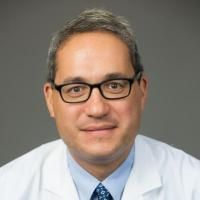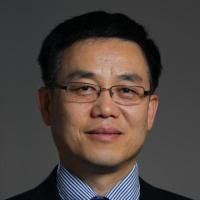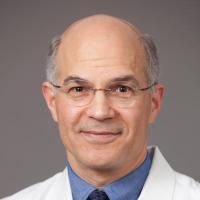The Actin-Binding Protein Drebrin Inhibits Neointimal Hyperplasia.
Date
2016-05
Journal Title
Journal ISSN
Volume Title
Repository Usage Stats
views
downloads
Citation Stats
Abstract
Objective
Vascular smooth muscle cell (SMC) migration is regulated by cytoskeletal remodeling as well as by certain transient receptor potential (TRP) channels, nonselective cation channels that modulate calcium influx. Proper function of multiple subfamily C TRP (TRPC) channels requires the scaffolding protein Homer 1, which associates with the actin-binding protein Drebrin. We found that SMC Drebrin expression is upregulated in atherosclerosis and in response to injury and investigated whether Drebrin inhibits SMC activation, either through regulation of TRP channel function via Homer or through a direct effect on the actin cytoskeleton.Approach and results
Wild-type (WT) and congenic Dbn(-/+) mice were subjected to wire-mediated carotid endothelial denudation. Subsequent neointimal hyperplasia was 2.4±0.3-fold greater in Dbn(-/+) than in WT mice. Levels of globular actin were equivalent in Dbn(-/+) and WT SMCs, but there was a 2.4±0.5-fold decrease in filamentous actin in Dbn(-/+) SMCs compared with WT. Filamentous actin was restored to WT levels in Dbn(-/+) SMCs by adenoviral-mediated rescue expression of Drebrin. Compared with WT SMCs, Dbn(-/+) SMCs exhibited increased TRP channel activity in response to platelet-derived growth factor, increased migration assessed in Boyden chambers, and increased proliferation. Enhanced TRP channel activity and migration in Dbn(-/+) SMCs were normalized to WT levels by rescue expression of not only WT Drebrin but also a mutant Drebrin isoform that binds actin but fails to bind Homer.Conclusions
Drebrin reduces SMC activation through its interaction with the actin cytoskeleton but independently of its interaction with Homer scaffolds.Type
Department
Description
Provenance
Subjects
Citation
Permalink
Published Version (Please cite this version)
Publication Info
Stiber, Jonathan A, Jiao-Hui Wu, Lisheng Zhang, Igor Nepliouev, Zhu-Shan Zhang, Victoria G Bryson, Leigh Brian, Rex C Bentley, et al. (2016). The Actin-Binding Protein Drebrin Inhibits Neointimal Hyperplasia. Arteriosclerosis, thrombosis, and vascular biology, 36(5). pp. 984–993. 10.1161/atvbaha.115.306140 Retrieved from https://hdl.handle.net/10161/30124.
This is constructed from limited available data and may be imprecise. To cite this article, please review & use the official citation provided by the journal.
Collections
Scholars@Duke

Jonathan Andrew Stiber

Lisheng Zhang
My research efforts involves studying the pathogenesis of vein graft neointimal hyperplasia and atherosclerosis.
The greatest amount of my time in the past years has been devoted to developing and characterizing our interposition vein graft model in mice. This model allows us to use IVC to carotid artery transplants between congenic mice. These transplants allow us to ask the questions about which gene products contribute to the pathogenesis of vein graft disease. In addition, I have used carotid artery to carotid artery transplants to study the role of TNF receptors in atherosclerosis. For these studies, we have used apolipoprotein E-deficient mice as graft recipients.
By using mouse vein graft model we demonstrate that most of the neointimal cells in vein grafts originate from cellular pools outside of the vein graft at the time of its implantation. The importance of this work relates to our persistent inability to treat vein graft disease in human beings. The second work demonstrates that expression of the tumor necrosis factor receptor-1, even in just in the vein graft cells themselves, contributes to the pathogenesis of vein graft neointimal hyperplasia. In this project, I surgically created chimeric mice to demonstrate molecular mechanisms by which the tumor necrosis factor receptor-1 aggravates neointimal hyperplasia, a process that is believed to lay the foundation for accelerated atherosclerosis in vein grafts.
I have also adapted my vein graft procedure in mice to ask questions about the arterial wall’s role in atherosclerosis. This atherosclerosis model involves making carotid interposition grafts not with veins, but with the carotid artery of congenic mice, and placing them into the carotid artery of spontaneously atherogenic mice that are deficient in apolipoprotein E.
I plan to continue our studies related to the role of inflammatory cytokine receptors in neointimal hyperplasia and atherosclerosis. In addition, I envision extending this work with the surgical models I have created in mice.

Rex Colle Bentley
Outcome-based research on pathology of endometrial carcinoma, including prognostic significance of histologic features of endometrial carcinoma, variants of endometrial carcinoma, definitions of atypia and well-differentiated carcinoma, and collaborative studies of oncogenes and tumor suppressor genes in endometrial carcinoma.
Endometrial pathology, especially as it relates to molecular/genetic alterations in neoplasms.
Ovarian pathology, especially as it relates to molecular and genetic alterations in neoplasms.
Improving accuracy of radiographic screening for breast cancer, by careful patho-radiographic correlation and study of improved imaging techniques (especially ultrasound).
Use of electron microscopy as a diagnostic and research technique.
Objective measures of pathology resident performance.

Paul Brian Rosenberg

Neil Jonathan Freedman
Our work focuses on atherosclerosis-related signal transduction and the genetic bases of atherosclerosis and vein graft failure, both in vitro and in vivo. We investigate the regulation of receptor protein tyrosine kinases by G protein-coupled receptor kinases (GRKs), and the role of GRKs and β-arrestins in atherosclerosis; the role of tumor necrosis factor and its receptors in atherosclerosis; and the role of the dual Rho-GEF kalirin in atherosclerosis. For in vivo modeling of atherosclerosis and neointimal hyperplasia, we use mouse carotid artery bypass grafting with either veins or arteries from gene-deleted or congenic wild type mice, as well as aortic atherosclerosis studies and bone marrow transplantation. To study receptor phosphorylation, signal transduction, and intracellular trafficking, we employ primary smooth muscle cells, endothelial cells, and macrophages derived from knockout mice or treated with RNA interference.
Key Words: atherosclerosis, G protein-coupled receptor kinases, arrestins, desensitization, phosphorylation, platelet-derived growth factor receptors, receptor protein tyrosine kinases, smooth muscle cells, neointimal hyperplasia, Rho-GEF.
Unless otherwise indicated, scholarly articles published by Duke faculty members are made available here with a CC-BY-NC (Creative Commons Attribution Non-Commercial) license, as enabled by the Duke Open Access Policy. If you wish to use the materials in ways not already permitted under CC-BY-NC, please consult the copyright owner. Other materials are made available here through the author’s grant of a non-exclusive license to make their work openly accessible.
